Opel Corsa B 1993–2000 Service and Repair Manual: Varajet ll carburettor - adjustments
Note: Under normal operating conditions only the carburettor idle adjustments will need attention. Checking and adjustment of the following settings is not a routine operation and should only be necessary after carburettor overhaul or if the operation of the carburettor is suspect.
Automatic choke carburettor
Fast idle speed
1. The engine must be at operating temperature and normal idle adjustments must be correct. The air cleaner must be removed and its vacuum hose plugged.
2. Connect a tachometer to the engine.
3. Slightly open the throttle valve plate so that the fast idle adjusting screw can be positioned on the second step of the cam (see illustration).
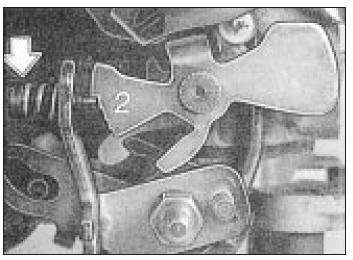
Fast idle screw (arrowed) positioned
on cam second highest step
4. Start the engine without touching the accelerator. The engine speed should be as specified; if not, turn the fast idle adjusting screw as necessary.
Choke pull-down (gap A)
5. In order to be able to carry out this adjustment, a suitable vacuum pump must be available. It is possible to create sufficient vacuum using a modified hand pump or by making a connection with a rubber hose or plastic tube between the choke vacuum unit of the carburettor and the inlet manifold of another vehicle (engine running).
6. Remove the air cleaner.
7. Position the fast idle screw on the uppermost step of the cam. Check that the choke valve plate is fully closed. This may not be the case if the choke cover is still warm, in which case use a rubber band to close it.
8. Apply vacuum to the choke vacuum unit as described in paragraph 6.
9. Measure the gap A between the edge of the choke valve plate and the wall of the carburettor. Measure at the flatter side of the valve plate. A twist drill or similar should be used as a gauge (see illustration). The gap should be as specified.
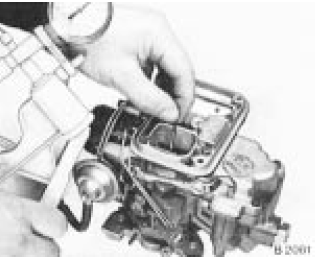
Choke pull-down measurement
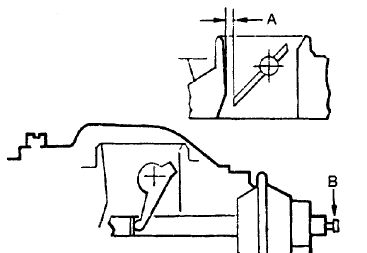
Choke pull-down measurement
- See Specifications (Choke valve gap A)
- Adjustment screw
10. If necessary, turn the screw B to bring the gap to the specified clearance. If the gap was found to be too small, it will probably be necessary to bend the pullrod slightly to provide sufficient clearance for movement of the adjustment screw.
11. On completion of adjustment, lock the adjustment screw with a drop of suitable sealant.
12. Now check the play between the baffle flap lever and the pullrod with the vacuum source still connected so that the pullrod is in the fully extended position (see illustration).
The clearance A must be as shown. Where necessary, bend the end of the pullrod to bring the clearance within tolerance.
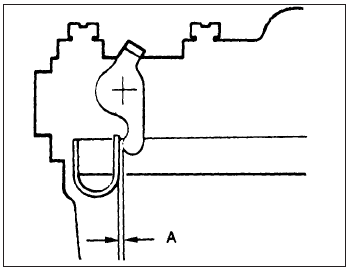
Baffle flap lever-to-pullrod clearance
A = 0.1 to 0.3 mm
Choke fast idle (gap B)
13. Close the choke valve with a rubber band.
14. Open the throttle and position the fast idle screw on the second highest step of the fast idle cam. Release the throttle and check that the screw stays on the step.
15. Open the choke valve slightly and release it in order to let it find its correct position.
Check the choke valve gap B by the same method as when checking the pull-down gap.
16. If adjustment is necessary, remove the carburettor and take off the choke cover.
Bend the rod which connects the fast idle cam to the choke valve lever until the gap is correct.
17. If adjustment has been necessary, recheck the pull-down gap after refitting the carburettor.
Full throttle opening
18. Close the choke valve with a rubber band.
19. Open the throttle fully and hold it open while measuring the choke valve gap C.
20. If adjustment is necessary, carefully bend that part of the linkage shown (see illustration). Bend the tag to the right to increase the gap, to the left to decrease it.
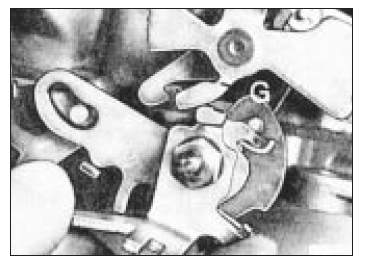
Full throttle opening adjustment -
bend tang G to adjust choke gap
Automatic choke cover
21. The pointer on the choke housing cover should be set against the mark given in the Specifications. If there is a tendency to stall or hesitate during warm-up, it is permissible to turn the cover through one or two divisions towards R (rich). The clamp ring screws must be slackened to do this.
22. If the ignition is switched on with the engine cold (approx 20ºC), the choke valve should open fully in three to four minutes. If a longer time is required, check the choke valve for free movement; renew the choke cover if the valve is free.
Accelerator pump
23. With the engine at operating temperature and the accelerator released, no clearance should exist between the pump operating lever and the pump plunger.
24. Have an assistant depress the accelerator to its full extent and hold it there. Press the pump plunger with a screwdriver and check that it will move further downwards before resistance is encountered.
25. Bend the pump operating lever as necessary to achieve these conditions.
26. Check that when the pump plunger is depressed, a jet of fuel is delivered towards the inner venturi If not, dismantle the carburettor And clean or renew the pump components.
Throttle damper adjustment (automatic transmission only)
27. Automatic transmission models are equipped with a throttle linkage damper, the purpose of which is to stop the throttle snapping shut suddenly when the pedal is released (see illustration).
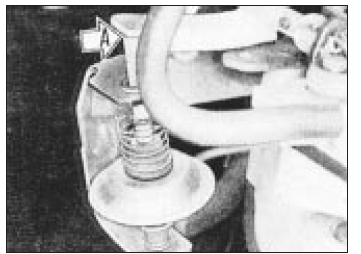
Carburettor throttle damper
- Damper pin
- Locknut
28. Correct adjustment of the damper is carried out as follows. Release the damper locknut and unscrew the damper until the damper pin is only just touching the throttle lever. From this position, screw the damper back in between 3 and 4 complete turns, then secure with the locknut.
Part load regulator screw adjustment
29. Problems such as jerking or hesitation at light throttle openings, or excessive fuel consumption despite moderate driving habits, may be due to incorrect adjustment of the part load regulator screw.
30. It is emphasised that this adjustment should not be attempted until all other possible causes of the problems mentioned have been investigated.
31. Remove the carburettor from the vehicle.
32. Prise out the metal plug covering the part load regulator screw (adjacent to the fuel inlet union).
33. If stalling or hesitation is the reason for adjustment - ie the mixture is too weak - turn the screw one-quarter turn anti-clockwise.
34. If excessive fuel consumption is the problem ie the mixture is too rich turn the screw one-quarter turn clockwise.
35. Refit the carburettor and test drive the vehicle to see if any improvement has occurred. If necessary a further adjustment can be made, but do not deviate from the original setting by more than half a turn of the screw.
36. Fit a new metal plug on completion, where this is required by law.
Manual choke carburettor
Fast idle speed
37. The idle speed must be correct and the engine must be at operating temperature.
Remove the air cleaner and plug its vacuum hose.
38. Pull out the choke until the mark on the fast idle cam is aligned with the tip of the fast idle adjustment screw (see illustration). Hold the choke valve plate open with a rubber band.
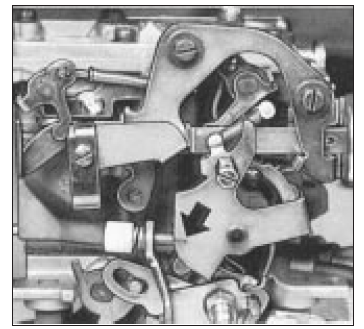
Mark on the fast idle cam (arrowed)
must be aligned with the tip of the screw
39. Connect a tachometer to the engine.
40. Start the engine and check the fast idle speed against that given in the Specifications.
If adjustment is necessary, turn the fast idle adjustment screw; the tamperproof cap over the screw head may be removed by crushing it with pliers.
41. Switch off the engine when adjustment is correct. Fit a new tamperproof cap where this is required by law.
Choke pull-down (gap A)
42. Remove the air cleaner.
43. Pull the choke control out fully. Apply vacuum to the choke vacuum unit, as described in paragraph 6. With the vacuum applied, measure gap A. Correction is by means of the adjusting screw on the vacuum unit.
44. Check the clearance between the baffle flap lever and the pullrod, as described in paragraph 13.
Other adjustments
45. Accelerator pump and part load regulator screw adjustments are as previously described for the automatic choke carburettor.
Idle cut-off solenoid - description and testing
1. Some of the carburettors described in this Chapter are fitted with an idle cut-off solenoid. This is an electrically-operated valve which interrupts the idle mixture circuit when the ignition is switched off, thus preventing the engine from running-on.
2. The idle cut-off solenoid is energised all the time that the ignition is switched on. A defective solenoid, or a break in its power supply, will cause the engine to stall or idle roughly, although it will run normally at speed.
3. If the operation of the solenoid is suspect, first check (using a 12 volt test lamp) that battery voltage is present at the solenoid terminal when the ignition is on.
4. With the solenoid unscrewed from the carburettor, connect the body of the solenoid to the negative terminal of a 12 volt battery.
When the battery positive terminal is connected to the solenoid centre terminal, there should be an audible click and the needle at the tip of the solenoid should retract.
5. A defective idle cut-off solenoid must be renewed.
 2E3 carburettor - adjustments
2E3 carburettor - adjustments
Note: Under normal operating conditions only
the carburettor idle adjustments will need attention. Checking and
adjustment of the following settings is not a
routine operation and should only be
n ...
 Carburettor - removal and
refitting
Carburettor - removal and
refitting
Note: Refer to the warning note in Section 1
before proceeding.
Removal
1. Disconnect the battery earth lead.
2. Remove the air cleaner.
3. Disconnect the choke cable (manual choke
models) or th ...
See also:
Opel Corsa B 1993–2000 Service and Repair Manual. Body electrical system
Specifications
General
Fuses - early models
Fuses - early models
Bulbs
...
